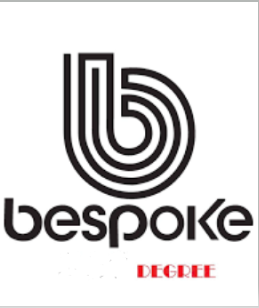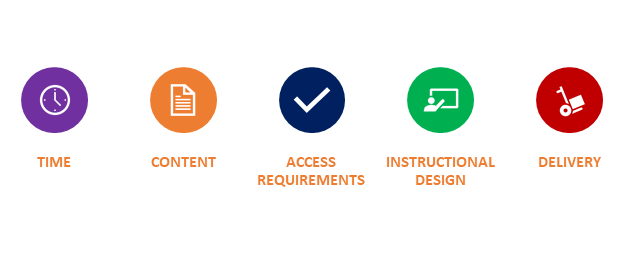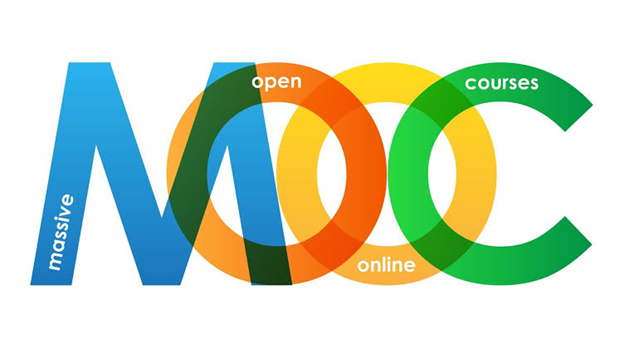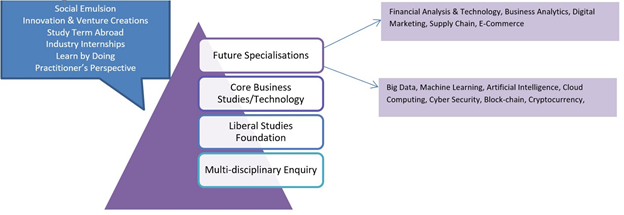Building a Bespoke Degree
Introduction
The modern world is full of complexities and the only constant thing is change. Currently, the ‘disruptive innovation’ has become synonymous with progress, wherein business models look completely different from those that exist in traditional setups. Many believe that we live in a VUCA world; the acronym initially coined by the US Army to refer ‘volatile, uncertain, complex and ambiguous’ environment. Are we, as Universities or higher education institutions, equipped to train students who can navigate this unpredictable minefield that the world is becoming? This lack of predictability regarding the events and their impact on our lives has led Universities to think about flexible education models.

Many educators and recruiters believe that future jobs are likely to be taken over by robots, artificial intelligence, IoT devices, autonomous vehicles amongst other technologies. A recent study at Oxford University states that about 47% of all-American jobs are at high risk of getting automated by early 2030, less than 10 years from today! The statistics certainly conveys a sense of doom and danger as it has universal repercussion, especially for a populous country like India. However, some researchers in the field of automation highlight that the jobs which fall into three ‘D’ categories, namely the dull, the dirty and the dangerous would eventually be taken over by the machines. Positively, this transition could lead to giving more space for human creativity and imagination to do the things which we humans are good at it and thus add value to the economy.
Nevertheless, the quintessential question arises, how can graduates of the future cope up with these changing times?

Therefore, Gen Z which are entering institutions of higher learning is increasingly building ‘Bespoke degrees’ wherein the key skills set that they wish to acquire in line with jobs of the future. Let us investigate as to how this development can be facilitated.
Flexible Education: A cornerstone to build Bespoke Degrees.
To build a fully flexible system of education, one needs to investigate flexibility along the following five dimensions:

Flexibility in Time explores possibilities of Program start and finish times to be flexible and not be bound to rigid semester schedules. Similarly, the length and pace of various academic programs can also be flexible leading to multiple assessment points and number of annual study periods.

Flexibility in Content implies that Program topics and their sequence can be modified by a specific learner. The types of learning materials, as well as assessment rubrics, can also vary with the need for a learner.
Flexibility in Access Requirements indicates that there could be multiple program entry and exit points as well as recognition of prior learning experience (RPL/E) and the possibility of using bridge courses as well as articulation into other programs.
Flexibility in Instructional Design means that learning mode (group, individual/independent, face-to-face), learning styles (slow, fast, aural, visual, simulated), language(s) of instruction learning delivery modes (lecture notes, printed study guides, recorded lectures) can be customised by using multiple providers of learning resources (teacher, students, library, internet, experience).

Flexibility in Delivery implies that learners can choose from amongst:
• Places of study
• (on-campus, off-campus, online, blended, offshore/twinning, work-based learning)
• The social organisation of Learning
• (contact with instructors and/or other students or individualistic)
• Methods of support and forms of assistance
• (Tutorials, FAQs etc)
• Content delivery channels
• (Physical, Online, Offline, Multimedia, Experiential etc)
• Access to program administrative information and processes
- (Physical, Online, Offline)
MOOC: A definite mode to assist Flexible Education

Massive open online courses (MOOCs) are being developed by premier institutions such as Stanford, Yale, Michigan, and Imperial College London, and others in the same league to deliver content to individuals around the world.
MOOCs make high-quality educational content available to the masses, leveraging videos, quizzes, and discussion forums typically within a four to six-week course session. Further, one’s location doesn’t matter, as long as one has a high bandwidth internet connection. Moreover, classes are self-directed, so they can fit around one’s schedule.
MOOCs reach wide audience cutting across cultures, professions, ages, and education backgrounds. Several MOOC providers have come to the fore to meet this broad audience. Among the most prominent providers are Coursera, edX, FutureLearn, Udacity, and Udemy.
Curating Content for Building Bespoke Degrees
As depicted in the graphic below, the flexible education model in the Universities of tomorrow coupled with the availability of MOOCs which can be integrated the next generation are curating their academic programs in the context of the needs of the 4th Industrial Revolution. Such programs are usually referred to as 4.0 programs in the context of Education 4.0 and Industry 4.0.

Such programs can be customized to produce Professional Triathletes who can excel in many dimensions that would be needed for the workforce in a VUCA world. This may include:
- The core of Business or Technology Discipline
- Specializations for careers of tomorrow
- Digital Marketing, Business Analytics, Machine Learning & AI, Internet- of-Things, Financial Technologies, etc.
- Liberal Dose of Liberal Studies
- A truly well-rounded personality building experience — courses on Literature, Performing & Visual Arts, Public Policy, Psychology, Sociology, Media, Design
Some of the MOOC providers are now developing special offerings of their courses to enable Universities to provide special cutting-edge content for their students. This helps students to add-on the emerging skill areas to their baseline degrees. One such example is Coursera who has developed a special offering for university campuses called ‘Coursera for Campus’ (C4C). One of the early adopters of this offering was Manipal Academy of Higher Education (Deemed University). The case study of this relationship and its outcomes follows: –
Case Study
CHALLENGE AREA FOR THE UNIVERSITY
Enabling a learning environment for students to keep up with the latest skills
In a world which is experiencing an agglomeration of factors such as industry 4.0, digital technologies and sustainability shaping its near- and long-term future, liberal education is expected to empower individuals and prepare them to deal with complexity and constant change. It provides students with a broad knowledge of the wider world (e.g. science, culture,and society) as well as in-depth study in specific areas of interest. Manipal Academy of Higher Education (MAHE) intended to create such an environment in its campus where students can pursue their personal and career aspirations along with their formal education. This was indeed progressive thinking by the University as to how to maintain the currency of content in a 3 to 4-year degree program.
MAHE chose to create a multi-disciplinary learning environment which made it possible for a student from a non-computer science background to pursue data science or for a doctoral student to pursue music. They wanted to enable an option for students to pursue learning in areas of their passion apart from their current degree program. They could also embellish their degree with add-on super-specialized emerging areas, leading to better employability.
PARTNERSHIP SOLUTION
Blending classroom learning with Coursera courses
MAHE wanted to partner with a learning provider who could provide relevant content from world-class institutions and blend it with expert pedagogy and technology that lets students learn anytime, anywhere. Therefore, Coursera came with a solution which evolved into ultimately C4C.
Coursera partnered with MAHE to develop a program with three objectives:
- To provide learning across different disciplines to over 20,000 students studying at various institutes under MAHE Manipal
- To provide an opportunity for faculty members to upskill and reskill across various domains
- To provide for-credit learning at different schools and colleges
This relationship provided an opportunity for their students to choose amongst the thousands of courses available on Coursera. As the Coursera platform has courses at all levels — beginner, intermediate, advanced as well as Specializations which make it convenient for students to embed courses at an appropriate level and earn credits.
OUTCOMES
Multiple outcomes emerged for various stakeholders of the university including the teachers and the students.
MAHE defined the success of this program based on each of the key stakeholders — the University, the faculty and the students.
The University management was looking to provide an environment in which students were able to learn what they want to learn. The faculty members wanted an opportunity to blend the quality content available online with the curriculum in the classroom. For students it was important to address questions such as-are they able to get an internship of their choice, are they able to pursue a career of their choice and are they able to get a job when they graduate?
The Coursera program for Manipal has helped meet the objectives of these stakeholders.
Over 69,000 courses have been enrolled in by students and faculty members across various campuses of Manipal Group. Nearly 70 courses have been inducted into the blended learning pedagogy for-credit. Almost 200,000 hours of learning has happened via this program making it one of the largest learning programs on Coursera. The students found that Coursera content has made a positive career impact for them.
They have learned and acquired skills that they couldn’t acquire otherwise and have thoroughly appreciated the flexibility of the online learning process.
(Source: Coursera India Private Limited)
Conclusion
Sensing the urgency of the imminent threat in the future job markets as well as the changed mindset of the upcoming generation, most countries are being forced to revisit their existing education policies and find measures to tackle the employability quotient. India is no different and the draft version of the new education policy (NEP) is a step in this direction. The policy attempts to address relevant changes required in the modern education system in the higher education segment and keeping in view with the emerging needs of Industry 4.0. A paradigm shift is suggested by it which places a great emphasis on online education as well as MOOCs. The policy recommends how online learning can be made integral to mainstream education. This indeed is a heartening step for the country.
No token or token has expired.
Deprecated: Function get_magic_quotes_gpc() is deprecated in /home1/silvege7/public_html/paradigmconsultant.com/wp-includes/formatting.php on line 4371
